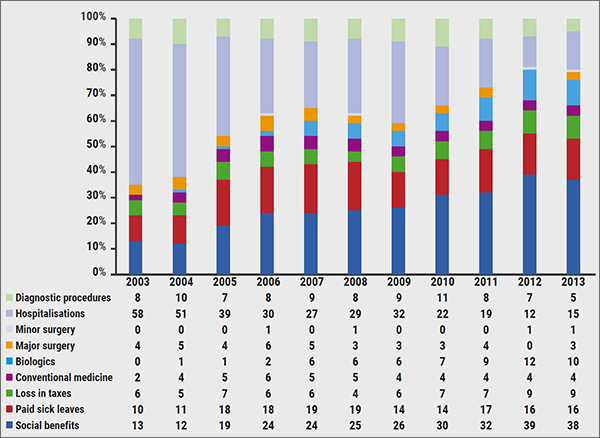Patients enrolled in OPERA II completed either 12 weeks induction treatment (placebo or SHP647 22.5 mg, 75 mg, or 225 mg subcutaneous) in the OPERA trial regardless of response or had a clinical response to SHP647 225 mg in the TOSCA trial. In OPERA II, they received SHP647 (75 mg) every 4 weeks from week 0–72 and were followed up monthly for safety for a further 24 weeks. Dose reduction to 22.5 mg or escalation to 225 mg was allowed from week 8 as judged by the investigator. High-sensitivity C-reactive protein (hsCRP), faecal calprotectin (FC), and Harvey-Bradshaw Index (HBI) score were assessed as exploratory efficacy endpoints.
Out of 268 participants, 149 completed the study. Remission rate (HBI <5) initially decreased in responders and increased in non-responders from baseline to week 8; it was then maintained in both groups to week 72 (see Figure). No patient de-escalated the dose, but 157 patients escalated to 225 mg. Those who escalated had slightly higher hsCRP and FC concentrations at baseline than those who remained on 75 mg (mean hsCRP, 22.8 vs 20.5 μg/ml; mean FC, 2,662.7 vs 1,988.8 mg/kg). hsCRP and FC levels were higher in patients who dose-escalated than those who remained on 75 mg subcutaneous, which adds to the evidence for long-term efficacy of SHP647.
Figure: Change over time in OPERA II in mean remission rate (HBI score <5) for responders and non-responders to treatment with SHP647 from OPERA and TOSCA trials [1]
 Includes all patients who escalated dose to 225 mg and those who remained on 75 mg SHP647.
Includes all patients who escalated dose to 225 mg and those who remained on 75 mg SHP647.
1. D’Haens G, et al. ECCO 2019, OP08.
Posted on
Previous Article
« Safety of thiopurine + allopurinol vs thiopurine monotherapy Next Article
Infliximab retreatment in luminal Crohn’s disease »
« Safety of thiopurine + allopurinol vs thiopurine monotherapy Next Article
Infliximab retreatment in luminal Crohn’s disease »
Table of Contents: ECCO 2019
Featured articles
Interview with Prof. Janneke van der Woude
New Compounds: Study Results
Short-term and Long-term Treatment Results
The right drug for the right patient
Vedolizumab superior to adalimumab in ulcerative colitis
Complementary and Alternative Medicine
Crohn’s disease exclusion diet + partial enteral nutrition in paediatric Crohn’s disease
Microbial composition and psychological wellbeing
Remission
Early remission of Crohn’s disease prevents progression
Proactive adalimumab trough measurements
Observational Studies
IBD risk of treatment with IL-17 antagonists
Basic and Preclinical Research
Immune cells and microbes: a happy marriage?
Genetics
Related Articles
May 9, 2019
Pathogenesis

May 9, 2019
The costs and benefits of biologicals
© 2024 Medicom Medical Publishers. All rights reserved. Terms and Conditions | Privacy Policy

